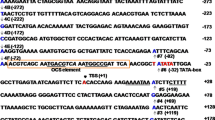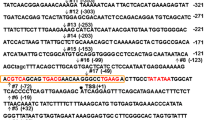Abstract
PR-1 genes are induced by various environmental stimuli such as pathogen attack or exposure of the plants to certain chemicals. To examine the regulation of these genes, the 5′ flanking regions of the PR-la gene and of two PR-1 pseudogenes were joined by a transcriptional fusion to theEscherichia coli β-glucuronidase (GUS) gene. These constructs were stably integrated into the tobacco genome and independent primary transformants were monitored for the expression of the reporter gene. Unexpectedly, out of 55 transformants analysed, four plants exhibited considerable GUS activities without any inductive treatment of the plants. Expression of the endogenous PR-1 genes, however, could not be detected in these plants. Primer extension analyses revealed correct initiation of the PR1/GUS hybrid transcripts from the PR-1a TATA box. When the plants were analysed at the cellular level, clear differences regarding the tissue specificity of expression of the reporter gene were observed. These results strongly suggest that the PR1/GUS hybrid promoter expression cassettes may be activated when integrated in the vicinity of heterologous enhancer elements dispersed in the tobacco genome. In order to support this hypothesis, domain B of the enhancer of the 35S RNA promoter from cauliflower mosaic virus (CaMV) was fused to various PR1/GUS hybrid genes upstream as well as downstream from the RNA start site. These constructs were stably introduced into the tobacco genome. In any primary transformant analysed, strong GUS activities were observed with the PR1/GUS hybrid RNAs originating from the normal transcription start site of the PR-1a gene. The tissue specificity of gene expression was identical to that described previously for the CaMV 35S domain B enhancer element. Thus, modulations of the transcriptional activity of the PR-1 promoter can be achieved by heterologous enhancers in transgenic plants and may be encountered upon random integration of PR-1 promoter constructs into the tobacco genome.
Similar content being viewed by others
References
Allen ND, Cran DG, Barton SC, Hettle S, Reik W, Surani MA: Transgenes as probes for active chromosomal domains in mouse development. Nature 333: 852–855 (1988).
Beilmann A, Pfitzner AJP, Goodman HM, Pfitzner UM: Functional analysis of the pathogenesis-related la protein gene minimal promoter region: Comparison of reporter gene expression in transient and in stable transfections. Eur J Biochem 196: 415–421 (1991).
Bellen HJ, O'Kane CJ, Wilson C, Grossniklaus U, Kurth Pearson R, Gehring WJ: P-element-mediated enhancer detection: a versatile method to study development inDrosophila. Genes Devel 3: 1288–1300 (1989).
Benfey PN, Ben L, Chua N-H: The CaMV 35S enhancer contains at least two domains which can confer different developmental and tissue-specific expression patterns. EMBO J 8: 2195–2202 (1989).
Bevan M:Agrobacterium vectors for plant transformation. Nucl Acids Res 12: 8711–8721 (1984).
Cornelissen BJC, Horowitz J, vanKan JAL, Goldberg RB, Bol JF: Structure of tobacco genes encoding pathogenesis-related proteins from the PR-1 group. Nucl Acids Res 15: 6799–6811 (1987).
Fraser RSS: Evidence for the occurrence of the ‘pathogenesis-related’ proteins in leaves of healthy tobacco plants during flowering. Physiol Plant Path 19: 69–76 (1981).
Gianinazzi S, Kassanis B: Virus resistance induced in plants by polyacrylic acid. J Gen Virol 23: 1–9 (1974).
Gianinazzi S, Martin C, Vallée JC: Hypersensibilité aux virus, température et protéines solubles chez leNicotiana Xanthi n.c. Apparition de nouvelles macromolécules lors de la répression de la synthèse virale. C R Acad Sci D270: 2383–2386 (1970).
Gossler A, Joyner AL, Rossant J, Skarnes WC: Mouse embryonic stem cells and reporter constructs to detect developmentally regulated genes. Science 244: 463–465 (1989).
Hooft van Huijsduijnen RAM, Alblas SW, deRijk RH, Bol JF: Induction by salicylic acid of pathogenesis-related proteins and resistance to alfalfa mosaic virus infection in various plant species. J Gen Virol 67: 2135–2143 (1986).
Horsch RB, Fry JE, Hoffmann NL, Eichholtz D, Rogers SG, Fraley RT: A simple and general method for transferring genes into plants. Science 227: 1229–1231 (1985).
Jefferson RA: Assaying chimeric genes in plants: the GUS gene fusion system. Plant Mol Biol Rep 5: 387–405 (1987).
Jefferson RA, Burgess SM, Hirsch D: β-glucuronidase fromEscherichia coli as a gene-fusion marker. Proc Natl Acad Sci USA 83: 8447–8451 (1986).
Jefferson RA, Kavanagh TA, Bevan MW: GUS fusions: β-glucuronidase as a sensitive and versatile gene fusion marker in higher plants. EMBO J 6: 3901–3907 (1987).
Logemann J, Schell J: Nucleotide sequence and regulated expression of a wound-inducible potato gene (wun1). Mol Gen Genet 219: 81–88 (1989).
Lotan T, Ori N, Fluhr R: Pathogenesis-related proteins are developmentally regulated in tobacco flowers. Plant Cell 1: 881–887 (1989).
Maniatis T, Goodbourn S, Fischer JA: Regulation of inducible and tissue-specific gene expression. Science 236: 1237–1245 (1987).
Mitchell PJ, Tjian R: Transcriptional regulation in mammalian cells by sequence-specific DNA binding proteins. Science 245: 371–378 (1989).
Ohshima M, Harada N, Matsuoka M, Ohashi Y: The nucleotide sequence of pathogenesis-related (PR) 1b protein gene of tobacco. Nucl Acids Res 18: 181 (1990).
Ohshima M, Harada N, Matsuoka M, Ohashi Y: The nucleotide sequence of pathogenesis-related (PR) 1c protein gene of tobacco. Nucl Acids Res 18: 182 (1990).
Ohshima M, Itoh H, Matsuoka M, Murakami T, Ohashi Y: Analysis of stress-induced or salicylic acid-induced expression of the pathogenesis-related la protein gene in transgenic tobacco. Plant Cell 2: 95–106 (1990).
Ohshima M, Matsuoka M, Yamamoto N, Tanaka Y, Kano-Murakami Y, Ozeki Y, Kato A, Harada N, Ohashi Y: Nucleotide sequence of the PR-1 gene ofNicotiana tabacum. FEBS Lett 225: 243–246 (1987).
Ow DW, Wood KV, DeLuca M, DeWet JR, Helinski DR, Howell SH: Transient and stable expression of the firefly luciferase gene in plant cells and in transgenic plants. Science 234: 856–859 (1986).
Payne G, Parks TD, Burkhart W, Dincher S, Ahl P, Metraux JP, Ryals J: Isolation of the genomic clone for pathogenesis-related protein la fromNicotiana tabacum cv. Xanthi-nc. Plant Mol Biol 11: 89–94 (1988).
Pfitzner AJP, Beilmann A, Goodman HM, Pfitzner UM: Molecular analysis of two PR-1 pseudogenes from tobacco. Plant Mol Biol 16: 129–139 (1991).
Pfitzner AJP, Pfitzner UM, Goodman HM: Nucleotide sequences of two PR-1 pseudogenes fromNicotiana tabacum cv. Wisconsin 38. Nucl Acids Res 18: 3404 (1990).
Pfitzner UM, Goodman HM: Isolation and characterization of cDNA clones encoding pathogenesis-related proteins from tobacco mosaic virus infected tobacco plants. Nucl Acids Res 15: 4449–4465 (1987).
Pfitzner UM, Pfitzner AJP, Goodman HM: DNA sequence analysis of a PR-1a gene from tobacco: Molecular relationship of heat shock and pathogen responses in plants. Mol Gen Genet 211: 290–295 (1988).
van deRhee MD, vanKan JAL, González-Jaén MT, Bol JF: Analysis of regulatory elements involved in the induction of two tobacco genes by salicylate treatment and virus infection. Plant Cell 2: 357–366 (1990).
vanLoon LC: Induction by 2-chloroethylphosphonic acid of viral-like lesions, associated proteins, and systemic resistance in tobacco. Virology 80: 417–420 (1977).
vanLoon LC: Pathogenesis-related proteins. Plant Mol Biol 4: 111–116 (1985).
vanLoon LC, vanKammen A: Polyacrylamide disk electrophoresis of the soluble leaf proteins fromNicotiana tabacum var. ‘Samsun’ and ‘Samsun NN’. II. Changes in protein constitution after infection with tobacco mosaic virus. Virology 40: 199–211 (1970).
White RF: Acetylsalicylic acid (aspirin) induces resistance to tobacco mosaic virus in tobacco. Virology 99: 410–412 (1979).
Author information
Authors and Affiliations
Rights and permissions
About this article
Cite this article
Beilmann, A., Albrecht, K., Schultze, S. et al. Activation of a truncated PR-1 promoter by endogenous enhancers in transgenic plants. Plant Mol Biol 18, 65–78 (1992). https://doi.org/10.1007/BF00018457
Received:
Accepted:
Issue Date:
DOI: https://doi.org/10.1007/BF00018457




